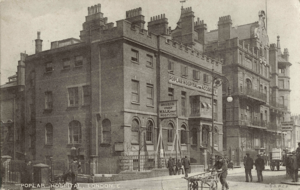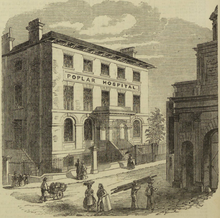
Poplar Hospital was a medical facility opened in East India Dock Road in London, England, in 1855. It was opened under the patronage of Samuel Gurney, MP, to treat people who had suffered injuries in the docks. The premises which were leased for the hospital were originally those of the East India Dock Tavern and then subsequently the Custom House.
Under Sydney Holland's chairmanship the hospital was able to expand considerably in the late nineteenth century. Holland was well known for his successful fundraising, for which he earned the nickname 'Prince of Beggars'. In a four-year period Holland raised sufficient funds to enlarge the hospital from 36 to over 100 beds, improved the nursing care, and the hospital's reputation.
The hospital was repeatedly expanded to cater for more patients, only being closed in 1975. It was demolished in 1982.

From the seventeenth to the early nineteenth century, the British East India Company (EIC) maintained a hospital in the area known as Poplar Hospital. The hospital had been established in March 1628 as an almshouse for its mariners.
Notable staff
- Emma Pilcher (abt 1845– ), Matron 1883 – until about 1891. She had previously trained at St Thomas's Hospital and Inverness. Pilcher was the first of three London Hospital nurses to work as Matron at Poplar in succession for over a forty-year period.
- Gertrude Vacher (abt 1864– ), Matron 1891–1895. Vacher trained at The London Hospital as both a paying and ordinary probationer between 1885 and 1887. Whilst matron at Poplar she was seriously ill with pneumonia, and resigned following her recovery. Sydney Holland purchased a grave plot at Brompton Cemetery, and organised death announcements.
- Selina Elizabeth Bland (1855–1931), Matron 1895–1926. Bland trained at The London Hospital under Eva Luckes from 1895 to 1897. Bland's application was supported by the House Committee at The London, and Sydney Holland, The Poplar Hospital Chairman, was very pleased with other London Hospital trained nurses who had moved to nurse at Poplar.
Citations and references
Citations
- ^ "East India Dock Road, North side: Poplar Hospital, Nos 305–479 (dem.) and All Hallows' Church | British History Online". British-history.ac.uk. Retrieved 9 August 2017.
- Prochaska, Frank (1992). Philanthropy and the Hospitals of London: The Kings Fund 1897–1990. Oxford University Press.
- Gore, John (1936). Sydney Holland: Lord Knutsford, A Memoir. John Murray.
- Gore, John (23 September 2004). Wallis, Patrick (ed.). Holland, Sydney George, second Viscount Knutsford (1855–1931), hospital administrator and reformer. Vol. 1. Oxford University Press. doi:10.1093/ref:odnb/33943.
- "Poplar Hospital – the first hospital for dockers – Leisure, health and housing". Port Cities. Retrieved 9 August 2017.
- Proceedings Relative to Ships Tendered for the Service of the United East-India Company, from the Twenty-sixth of March, 1794, to the Sixth of January, 1795: With an Appendix, pp.698–699.
- Statutes at Large ...: (29 v. in 32) Statutes or the United Kingdom. (1821), pp.211–3.
- Makepeace (2010), p.71.
- ^ Rogers, Sarah (2022). 'A Maker of Matrons’? A study of Eva Lückes’s influence on a generation of nurse leaders:1880–1919' (Unpublished PhD thesis, University of Huddersfield, April 2022)
- Holland, Sydney (1926). In Black and White. Edward Arnold. pp. 135–136.
- House Committee Meeting, 1 April 1895; House Committee Minutes, 1895–1897; RLHLH/A/5/46, 59–60; NHS Trust Archives and Museums, London
- Matron’s Annual Letter, No.3; Matron’s Annual Letter to Nurses, 1894–1916; RLHLH/N/7/2, No.3, June 1896, 8; Barts Health NHS Trust Archives and Museums, London
References
- Makepeace, Margaret (2010) The East India Company's London Workers: Management of the Warehouse Labourers, 1800–1858. (Boydell & Brewer). ISBN 9781843835851
51°30′42.36″N 0°0′25.38″W / 51.5117667°N 0.0070500°W / 51.5117667; -0.0070500
Categories: